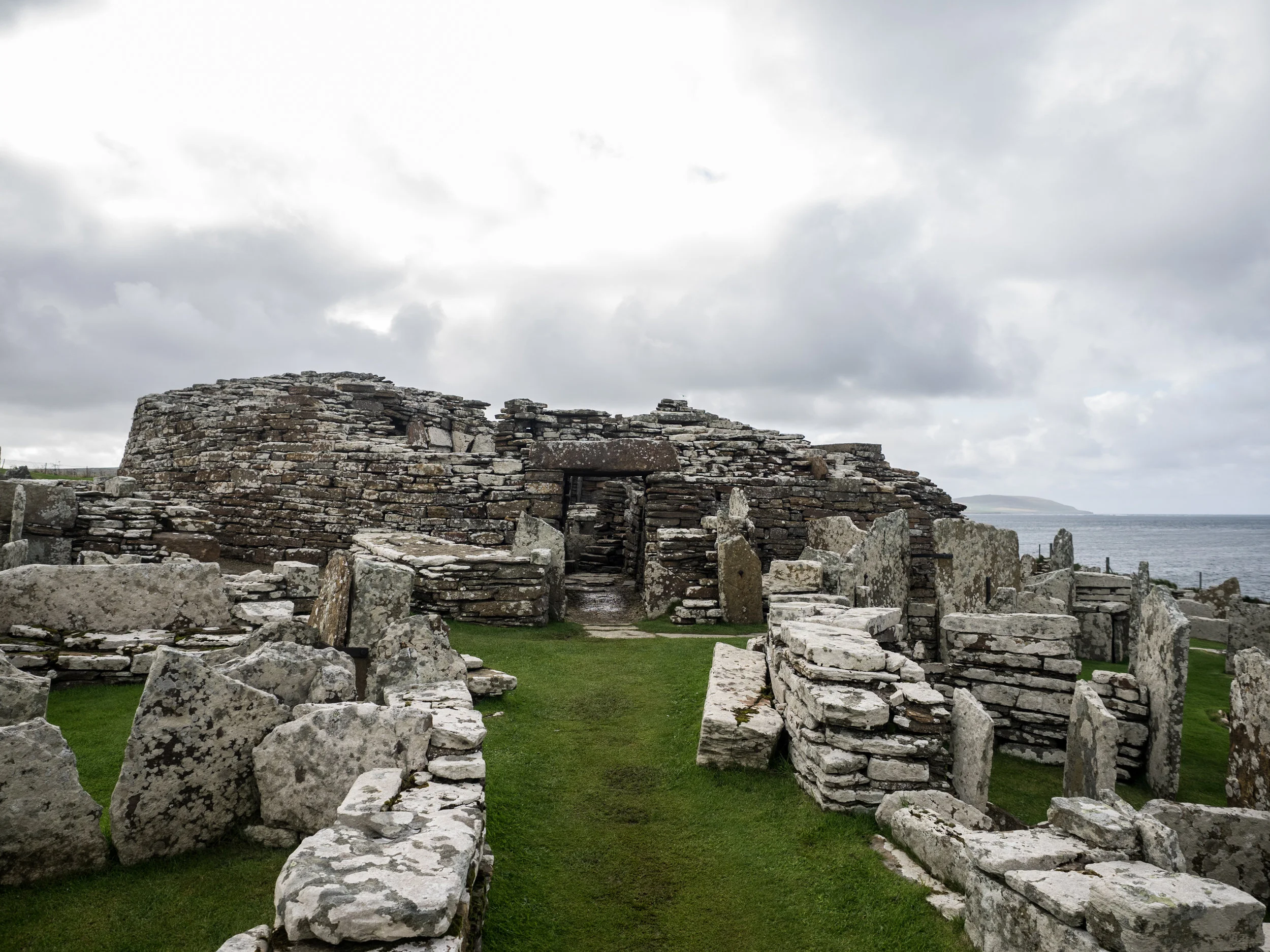Orkney 2 - 5000 Years of Living
Coming from Australia, where we are learning that the indigenous people have lived on the land for more than 60,000 years, Orkney’s 5000(ish) years of settlement seems quite short.
But when you think of globally celebrated ancient civilizations, who ALSO left behind structures (remembering that indigenous Australians were predominately nomadic), the Orcadian history and archeological sites certainly are ancient and impressive.
Visiting abandoned places that were inhabited 5000, 3000 and 1000 years ago, all the while camping next to today’s bustling port town, gave me a real sense of how the spirit of this place has persisted.
Skara Brae, a Neolithic village built around 3180BC and inhabited until 2500BC was hidden under the sands of Skaill Bay for 40 centuries. A 19th century storm uncovered the near-perfectly preserved remains of the village that was discovered by the owner of Skaill House – a 17th century manor built less than 200 metres away from the ancient village. The bay is peaceful, beautiful yet wild, and it is not hard to see why Orcadians have been building homes here for the last 5000 years.
Visiting Skara Brae is an incredible privilege. The preservation of the homes is impressive – each built to the same design and all interconnected by a series of tunnels.
The homes have beds, a central hearth and a dressing table – a humble reminder of the practical and emotional needs we humans have to display our prized possessions. The wind tears through the old homes and tunnels, and so too through our bones. Amidst mutterings of the strength of Orcadians, we head back to the warm car and onward.
The Brough of Gurness stands on a different shore of Mainland – along the North-West coast, above the Eynhallow Sound and looking over to the Isle of Hoy. This Iron Age village – built between 200 and 500 BC, would have been originally built up around a 10 metre tall broch and was probably inhabited intermittently up until the 9th century.
A broch is a drystone, hollow-walled structure, usually up to 10 metres tall and found exclusively in Scotland in the centre of iron age villages. This was the first broch we visited, and while the age an preservation of Skara Brae amazed us, the scale and intricacy of the tower and surrounding buildings of Gurness also impressed. After wandering amongst the ruins, noting both progress and similarities spanning the 2000 years of architecture, we head onward again to the past.
To ‘fill in the gap’ for what happened on Orkney between the Iron Age and the town near our little campsite, we headed to the Brough of Birsay., The remnants of the Pictish and then Norse settlements are located on this now uninhabited tidal island of the North-West coast of Mainland Orkney. There is something about walking to an island that intrigues us, so we made sure to visit this place at the perfect time of the day. Among and above the intertidal zone, on a somewhat slippery concrete walkway, we wandered to the island.
The remains of the 12th century Norse settlement overlays the earlier (7th – 9th century) Pictish ruins. The sharp corners of the Norse construction strike us, in stark contrast to the curves of Skara Brae and Gurness. Walking through the remains, we feel most familiar in these more advanced spaces; a church, a hall, and houses with heating, drainage and even some evidence of saunas. These are clearly built with comfort in mind, especially compared to the more practical design of the earlier Orcadian homes.
Before Kirkwall; the modern seat of Orcadian ‘power’, Birsay was home to the local kings. According to the Orkneyinga saga; the semi-mythical tales of the conquest and rule of Orkney by Harald Fairhair, the King of Norway, the main residence of Jarl Thorfinn the Mighty (1014–1065) was located in Birsay. This explains the grandeur of the remains.
The beauty and intrigue of this place is not lost on tourists, as we all pack onto the island during the brief interlude between high tides. We walk back to Mainland, past the encroaching tide, jagged rocks and gently floating seaweed.
To have these three well preserved sites spanning 5000 years, all within 20 miles and each built directly adjacent to or on top of other Orcadian settlements, is so important and so interesting. Having spent only a few windy nights here in our tent, I think these sites are a testament to the generations of Orcadians.
People who felt so strongly about these places that they consistently wanted to stay in this gloomy yet magical landscape. They have somehow maintained not only these ancient places (albeit, taking a few stones here and there to build newer homes, as needed), but have also persisted in a location that many others would find far too difficult.
The emigration from the Scottish Isles to mainland UK and beyond is one of the biggest threats to the future of these communities. I know why young people, after jobs and friends and fun, would head to bigger cities. Or maybe they are just hoping to escape the wind and rain.
But if the draw of this place, and indeed every island we have visited in Scotland, is felt by me – a foreigner with a simple affinity for rugged places, I can only imagine how strongly a far flung Orcadian living London might yearn for these windy open spaces. Maybe the lure of 'isolation' will save the Orkney community and preserve their ancient ruins as generations move to seek out more time and space.























